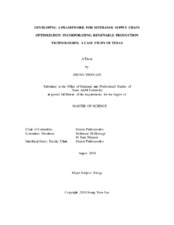| dc.description.abstract | Solving the environmental and societal problems associated with rising greenhouse gas (GHS) emissions and climate change are crucialchallenges our global society is currently facingin order tosecurea sustainable future.A potential solution to this global issueis the conversion of carbon free thermal and kinetic energy from the sun and wind into a manageable energy such as electricity. However, the intermittent natural ofsolar and wind energies greatly hinders the practical application of renewable technologies into electricity generation. Hence, theconversion of renewable energy into anenergy carriers, specificallymethanol,is investigated in this research.
A Mixed Integral Linear Programming (MILP) model was developedas a framework for renewable energy generated methanol to meet the electricity demands of Texas.Renewable energy potentials of solar (kWh/m^2/day) and wind (m/s)and associated capacity factorswere consideredper county of Texas. Themodel calculatesall the costs associated with building and operating the selected renewable power plants, electrolyzer systems, methanol production plants, Carbon Capture Unit (CCU) for Carbon Dioxide (COv2) capture and compression, and transportation costs of water, Carbon Dioxide (COv2), and product. The total cost wasminimized to identify the most optimal locations of plantconstruction for renewable energy generated methanol.
Based on the results of this supply chain optimization model, the Levelized Costof Energy (LCOE) for the production of renewable energy generated methanol to meet the demands of the top five energy consuming counties of Texas isestimated to be $29.58/GJ to $30.92/GJ without thesaleof Oxygen(Ov2)gas and $25.09/GJ to $26.28/GJ withthe sale ofOxygen. The sale of Oxygen is only considered at a 50% discount price of current selling priceto consider the price elasticity of the market.Wind power plantswas selected over solar power plants for methanol productionwhich showed that wind energy was more cost competitive than solar energy. A rudimentary case study was conducted to calculate theLCOE ofsolar energy poweredmethanol productionwhich is roughly $38/GJto meet the 44 % of total energy consumption of Texas. Further work can be doneon the supply chain networkto compare thecostcompetitiveness ofmethanol production asenergy carriersto that of hydrogen production. | en |


